PERTANIKA JOURNAL OF SCIENCE AND TECHNOLOGY
e-ISSN 2231-8526
ISSN 0128-7680
Formation of Methyl Pyrazine during Cocoa Bean Fermentation
Jinap Selamat, Siti mordingah Harun and Norsiati Mohd. Ghazali
Pertanika Journal of Science & Technology, Volume 17, Issue 1, April 1994
Keywords: cocoa beans, fermentation, wooden box fermentation, fermentation, pyrazines,Bascillus sp. fermentation index, bean pH, pod-storage
Published on:
A study on the effect offour fermentation techniques currently practised in Malaysia on the types and amount of pyrazines produced and the growth o/Bacillus sp. in cocoa beans was carried out. Freshly harvested beans were fermented using wooden shallow (032m in depth), medium (0.61m), deep (0.90m) boxes for 6 d and turned every 48h for the shallow and medium fermentations, and every 24 h for the deep fermentation; beans that had undergone 10 d pod storage were also fermented in shallow box for 5 d and turned on 48th hour. Samples were determined for nib pH, titratable acidity, fermentation index and pyrazines. Number of Bacillus sp. bacteria were monitored and identified. The type and amount of pyrazines detected varied with the techniques employed. Pod-stored samples ontained 2,3,5,6-tetramethylpyrazine (19.8ug/100g) and the highest concentration of 2,3,5- imethylpyrazine (23.0ug/ lOOg), 2,5-dimethylpyrazine (154.8ug/100g) and total pyrazine (177.6ug/100g). Samples fermented in shallow and medium box fermentations contained 2,3,5-trimethylpyrazine and 2,5- dimethylpyrazines; those of the deep box contained only 2,5-dimethylpyrazine. Bacillus sp. increased along with 2,3-dimethylpyrazine, 2,3,5- trimethylpyrazine and total pyrazine as fermentation period increased, with a correlation (r2) of0.90. The isolated Bacillus sp. were identified as B. subtilis and B. megaterium. 2,5-dimethylpyrazine was present in all samples;the component could be common in cocoa fermented in Malaysia.
ISSN 0128-7680
e-ISSN 2231-8526




